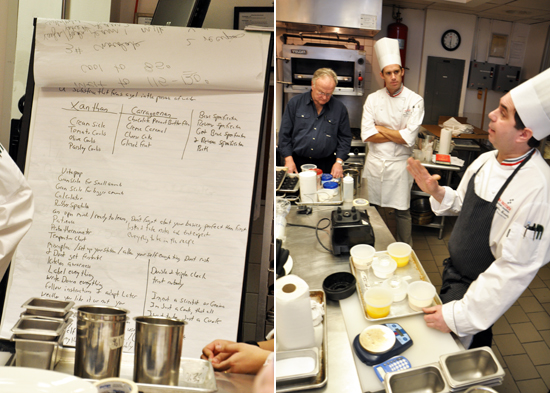Well, it finally happened. After nearly a year of being a skeptical observer Chef Chris Gesualdi dragged me kicking and screaming into the big, scary world of Hydrocolloids.

After poking and prodding around for a bit I realized something — it turns out it's not so scary after all. Hydrocolloids need a better publicist or an image consultant at the very least. They don't have a flashy name or a description that rolls off the tongue. But those are things better left for someone smarter than me. There is a lot of necessary fear around “chemicals,” especially when it comes to food.
So what are hydrocolloids, and why does everyone call them chemicals with a hint of terror in their voice? The fact is that hydrocolloids simply refer to a category of substances that form a gel in the presence of water. What does that mean? Here are some examples of hydrocolloids and chemicals you might find in your own kitchen:
Hydrocolloids commonly found in the kitchen are flour, cornstarch, pectin, and gelatin. To assuage any fears you have, “chemicals “commonly found in the kitchen are baking soda and baking powder. Most people associate hydrocolloids with the cool tricks that have trickled down to chefs all over the country from the kitchens of avant-garde kitchens of northern Spain (ahem, El Bulli). But you're much more likely to come across them in your everyday life — hydrocolloids keep the water from running out of your ketchup, prevent the salad dressing on the supermarket shelf from separating into layers oil and vinegar and makes sure your ice cream is creamy.
There are a million practical uses for hydrocolloids. Gelling agents like agar, carrageenan or gellan can be substituted for gelatin in any recipe, often with better results. The particulars of why you might use one in a specific recipe over another take a little time to learn. But a great to place to start is by knowing that there is a difference, and trust that eventually you’ll figure out the advantages to using the right tool for the right job. Armed with that knowledge and a desire to learn the possibilities are endless.
So if you're interested in taking your cooking to the next level, register for Chef Chris's next ABCs of Hydrocolloidsclass. I'll be there playing the role of the lovely assistant. Or just hang around this blog and I'll do my best to share what we’re up to with Y'all. But let's be honest, you clicked on this for the “cool tricks”, so here it is.
Spiced Yogurt Encapsulated in Carrot Skin
Ingredients
- 500 grams carrot juice
- 4 grams of sodium alginate
- 120 grams plain yogurt
- Ground cumin, coriander, cayenne, salt, and pepper to taste
Instructions
- Place the carrot juice in a blender and mix on low. When a whirlpool forms, add the sodium alginate and continue mixing 10 seconds more. Pour the carrot juice into a container and rest in the refrigerator overnight.
- Season the yogurt to taste with ground cumin, coriander, cayenne, salt, and pepper. Use the yogurt to fill small silicone hemisphere molds and freeze.
- Remove the carrot juice bath from the fridge and bring to room temperature. Drop the frozen yogurt into the carrot bath and leave 3 to 4 minutes or until thawed completely.
- Transfer the spheres to a bowl of clean water to rinse. Serve within 1 hour.



